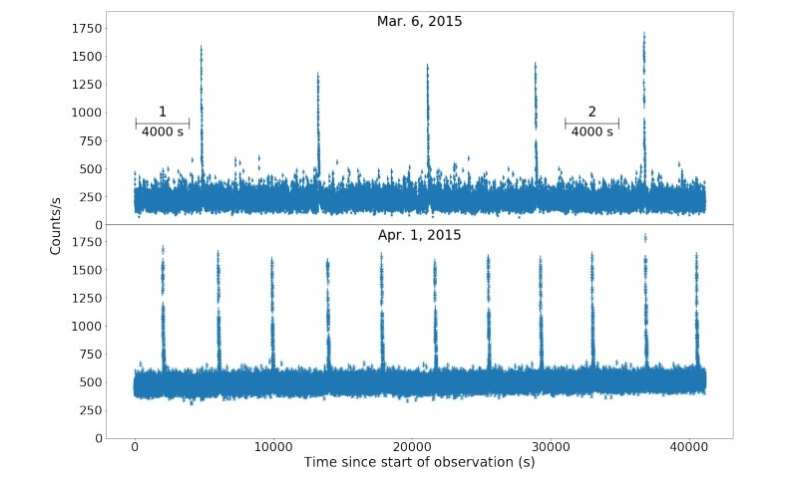Millihertz quasi-periodic oscillations detected in an X-ray binary
by Tomasz Nowakowski
Astronomers from Australia and Taiwan report the discovery of millihertz quasi-periodic oscillations in a neutron-star low-mass X-ray binary known as 1RXS J180408.9−342058. The discovery, detailed in a paper published September 3 on the arXiv preprint server, could help astronomers better understand the nature and behavior of X-ray binary sources.
X-ray binaries consist of a normal star or a white dwarf transferring mass onto a compact neutron star or a black hole. Based on the mass of the companion star, astronomers divide them into low-mass X-ray binaries (LMXBs) and high-mass X-ray binaries (HMXBs).
Most of the low-mass X-ray binaries containing neutron stars (NS LMXBs) exhibit X-ray variability in the form of relatively sharp quasi-periodic oscillations (QPOs) with millihertz (mHz) to kilohertz (kHz) frequencies. Researchers believe that QPOs occur when X-rays are emitted near the inner edge of an accretion disk in which gas swirls onto a compact object like a neutron star or a black hole.
1RXS J180408.9−342058 was initially identified as a transient X-ray binary in 2012 by the INTErnational Gamma-Ray Astrophysics Laboratory (INTEGRAL) spacecraft. Further observations of this source have suggested that it is most likely an NS LMXB located at a distance not greater than 18,900 light years.
Now, a team of researchers led by Kaho Tse of Monash University, Australia, has detected mHz QPOs from 1RXS J180408.9−342058, which could shed more light on the properties of this source and on the nature of NS LMXBs in general. The finding was made using ESA's X-ray Multi-Mirror Mission (XMM-Newton) satellite.
"In this paper, we report timing analysis of XMM-Newton data from 1RXS J180408.9−342058. We report the detection of significant periodic signals with frequency in the range ∼ 5 to 8 mHz from the source," the astronomers wrote in the study.
The mHz QPOs were discovered during a regular bursting phase of an outburst that 1RXS J180408.9−342058 experienced in 2015. XMM-Newton observed the source in March and April 2015, and identified QPOs with frequencies between 5.0 and 8.0 mHz, having fractional root mean square (RMS) amplitude at a level of approximately 5.3 percent.
According to the study, when the mHz QPOs were present, 1RXS J180408.9−342058 was in a very hard state (photon index below 1.4) at persistent luminosity of 6.8 undecillion erg/s. Then the source transited to a hard state, which was accompanied by an increase of its persistent luminosity.
As in the case of other NS LMXB systems experiencing mHz QPOs, the authors of the paper assume that those in 1RXS J180408.9−342058 are also related to the thermonuclear burning on the neutron star surface. Therefore, they noted that 1RXS J180408.9−342058 is so far the ninth NS LMXB known to experience mHZ quasi-periodic oscillations and the eight source of this type exhibiting such QPOs driven by thermonuclear burning.
More information: Tse et al., Detection of Millihertz Quasi-Periodic Oscillations in the X-Ray Binary 1RXS J180408.9−342058, arXiv:2009.01536 [astro-ph.HE] arxiv.org/abs/2009.01536
© 2020 Science X Network